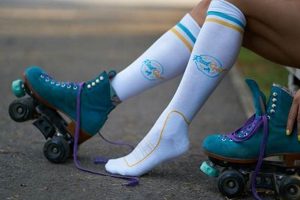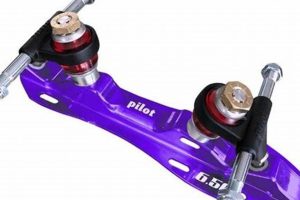Apparel designed for skateboarding that prioritizes affordability is often constructed from durable, yet economical materials. This category of clothing generally includes items like reinforced denim pants, t-shirts made from heavier cotton blends, and budget-friendly sneakers with vulcanized soles. A practical illustration is purchasing a set of plain, sturdy t-shirts in bulk rather than opting for branded skateboarding apparel.
The significance of cost-effective skateboarding attire lies in its accessibility, enabling broader participation in the sport, particularly among individuals with limited financial resources. Historically, skaters have often customized or repurposed readily available and inexpensive clothing to suit the demands of the activity. This approach allows individuals to focus on skill development rather than the perceived need for expensive, specialized gear. The availability of affordable options also reduces the barrier to entry for beginners.
This article will delve into the specific characteristics of durable and low-cost materials suitable for skateboarding. Furthermore, strategies for finding economical options through sales, discounts, and repurposing existing clothing will be examined. Finally, practical tips for maintaining and repairing such attire to extend its lifespan and maximize value will be provided.
Strategies for Economical Skateboarding Apparel
The following provides practical strategies for acquiring skateboarding attire without incurring significant expenses. These tips emphasize durability, resourcefulness, and long-term value.
Tip 1: Prioritize Durability in Material Selection: Opt for heavier-weight fabrics and reinforced construction. Denim jeans, even if not specifically marketed for skateboarding, offer substantial abrasion resistance. Look for shirts constructed from thicker cotton blends to withstand repeated falls and slides.
Tip 2: Scour Sales and Discount Outlets: Regularly check online retailers and physical stores for clearance events and end-of-season sales. Basic t-shirts, jeans, and athletic shoes are often heavily discounted. Subscribing to email newsletters can provide early access to sales and exclusive promotions.
Tip 3: Consider Secondhand Options: Thrift stores and online marketplaces can yield significant savings on pre-owned clothing. Examine items carefully for signs of wear and tear, but minor imperfections can often be repaired. Focusing on durable materials increases the likelihood of finding usable items.
Tip 4: Learn Basic Repair Skills: Mastering simple sewing techniques, such as patching holes and reinforcing seams, significantly extends the lifespan of skateboarding apparel. A basic sewing kit and online tutorials provide the necessary resources for these repairs.
Tip 5: Repurpose Existing Clothing: Before purchasing new items, evaluate existing wardrobe for suitable pieces. Older jeans can be cut into shorts. T-shirts with minor damage can be repurposed as cleaning rags. This reduces waste and minimizes expenses.
Tip 6: Focus on Functionality Over Brand: Avoid prioritizing expensive branded skateboarding apparel. Generic alternatives often provide similar levels of durability and protection at a fraction of the cost. The primary focus should be on functionality and resistance to wear and tear.
Tip 7: Look for Bulk Purchase Options: Purchasing basic items, such as t-shirts or socks, in bulk can reduce the individual item cost. This is particularly advantageous for frequently replaced items. Consider coordinating bulk purchases with other skaters to maximize savings.
By adhering to these guidelines, individuals can acquire suitable skateboarding apparel without exceeding budgetary constraints. Emphasis on durability, resourcefulness, and proactive maintenance maximizes the value and lifespan of each item.
The following section explores material choices that balance cost-effectiveness with durability.
1. Material Durability
Material durability constitutes a foundational element in the pursuit of affordable skateboarding attire. The longevity of clothing directly impacts its cost-effectiveness over time, rendering the selection of robust materials crucial for minimizing replacement expenses. The subsequent analysis outlines key facets of material durability within the context of economically viable skateboarding apparel.
- Abrasion Resistance
Abrasion resistance refers to a material’s ability to withstand friction and surface wear. Skateboarders subject clothing to considerable abrasion through falls, slides, and contact with the board’s grip tape. Denim, canvas, and heavy-duty cotton blends demonstrate higher abrasion resistance compared to lighter, less dense fabrics. Selecting garments constructed from these materials prolongs their lifespan and reduces the frequency of replacements.
- Tear Strength
Tear strength indicates a material’s resistance to tearing under stress. Skateboarders often encounter situations where clothing can be snagged or ripped. Fabrics with high tear strength, such as ripstop nylon or densely woven cotton twill, are less susceptible to tearing. This characteristic is particularly important in areas prone to stress, such as knees and elbows.
- Seam Strength
Seam strength denotes the durability of the stitched connections within a garment. Weak or poorly constructed seams are prone to failure under the stresses of skateboarding. Reinforced seams, achieved through double stitching or overlocking, enhance the overall durability of the garment and prevent premature separation. The type of thread used also plays a vital role; stronger synthetic threads are preferable to weaker cotton threads.
- Colorfastness
Colorfastness refers to a material’s ability to retain its original color through repeated washing and exposure to sunlight. While primarily an aesthetic consideration, significant fading or discoloration can prematurely age a garment, leading to its replacement. Materials with good colorfastness maintain their appearance for longer, extending the perceived and actual lifespan of the clothing.
These facets underscore the significance of material durability in relation to affordable skateboarding clothing. By prioritizing garments constructed from abrasion-resistant, tear-resistant, and colorfast materials with robust seam construction, skateboarders can effectively minimize apparel costs over the long term. The initial investment in durable materials yields substantial returns in terms of reduced replacement frequency and extended garment lifespan.
2. Reinforced Construction
Reinforced construction is a critical determinant of the long-term cost-effectiveness of skateboarding apparel. While initial price points may classify an item as “cheap skate clothes,” the absence of reinforcement can lead to premature failure and, consequently, increased replacement costs. Reinforced construction, encompassing techniques such as double stitching, bar tacking at stress points, and the incorporation of additional fabric layers in high-wear areas, directly addresses the elevated demands placed upon clothing during skateboarding activities. The cause-and-effect relationship is evident: inadequate construction yields rapid deterioration, negating the initial cost savings. Examples include jeans with reinforced knees that withstand repeated falls, or t-shirts with reinforced collars that resist stretching and tearing.
The importance of reinforced construction as a component of affordable skateboarding apparel lies in its ability to extend the usable life of garments. Consider a pair of jeans costing $20 with reinforced knees lasting six months, compared to a pair costing $15 without reinforcement lasting only two months. The former, despite its higher initial cost, presents a more economical solution over time. Furthermore, reinforced construction contributes to skater safety by minimizing the risk of clothing failure during maneuvers, which could potentially lead to injuries. Practical application involves carefully examining garments for reinforced seams and stress points prior to purchase.
In conclusion, while the allure of inexpensive skateboarding clothing is understandable, the absence of reinforced construction undermines its long-term value. A focus on durability through reinforcement strategies translates into a more sustainable and economically sound approach to skateboarding apparel. The challenge lies in identifying garments that effectively balance cost and construction, demanding a discerning approach to purchasing and a deeper understanding of garment construction principles. Understanding this relationship is crucial for skaters seeking affordable options without sacrificing performance or safety.
3. Cost-Effective Brands
The pursuit of “cheap skate clothes” often leads individuals to consider brands that provide a balance between affordability and durability. These brands occupy a critical space in the skateboarding apparel market, offering accessible options without necessarily sacrificing essential qualities. Examining the characteristics and strategies of these brands is paramount for skaters seeking economical choices.
- Value-Oriented Design
Cost-effective brands often prioritize functionality and durability over elaborate designs or marketing campaigns. This approach allows them to reduce production costs and offer more competitive pricing. For instance, a brand might opt for simpler screen-printed logos on durable t-shirts instead of investing in intricate embroidery or expensive fabric blends. The focus remains on creating garments that withstand the rigors of skateboarding while maintaining affordability. These brands concentrate on core skateboarding needs, avoiding stylistic excesses that drive up prices.
- Direct-to-Consumer Models
Some cost-effective brands leverage direct-to-consumer (DTC) business models to eliminate intermediary markups. By selling directly to consumers through online platforms, these brands can bypass traditional retail channels and offer lower prices. This approach allows them to control pricing and maintain a closer relationship with their customer base, often providing better value for the money. This is crucial for skaters seeking affordable options, as it removes the retail premium often associated with established brands.
- Material Sourcing Strategies
Strategic material sourcing is essential for cost-effective brands. They often utilize bulk purchasing, negotiate favorable rates with suppliers, and explore alternative materials that offer similar performance characteristics at lower costs. Examples include using recycled cotton blends or sourcing denim from regions with lower production costs. By optimizing their supply chain, these brands can minimize material expenses without compromising the quality or durability of their garments. This careful management of resources translates directly into more affordable clothing for skaters.
- Targeted Marketing and Distribution
Cost-effective brands frequently employ targeted marketing strategies to reach their core audience of value-conscious skaters. They may focus on online advertising, social media engagement, and collaborations with local skate shops to promote their products. Their distribution channels are often streamlined, focusing on online sales or partnerships with select retailers that align with their target market. By avoiding expensive mainstream advertising campaigns and maintaining efficient distribution networks, these brands can minimize marketing and logistical costs, ultimately benefiting consumers through lower prices.
These facets of cost-effective brands highlight the diverse strategies employed to provide affordable skateboarding apparel. Through value-oriented design, direct-to-consumer models, strategic material sourcing, and targeted marketing, these brands contribute significantly to making skateboarding more accessible. By carefully evaluating these factors, skaters can identify brands that offer a compelling combination of affordability, durability, and functionality, thus optimizing their apparel budget.
4. Sale Opportunities
The availability of reduced-price merchandise significantly impacts the accessibility of skateboarding, allowing individuals to acquire necessary apparel without incurring substantial financial burden. Exploiting sales strategically is essential for obtaining “cheap skate clothes” and maximizing budgetary efficiency.
- Seasonal Clearance Events
Retailers often conduct clearance events at the end of each season to liquidate existing inventory. These events frequently feature substantial discounts on a wide range of items, including clothing suitable for skateboarding. Examining these sales presents opportunities to acquire durable jeans, t-shirts, and shoes at significantly reduced prices. For example, end-of-summer sales may include discounted shorts and lightweight tops, while winter clearance events could offer deals on heavier jackets and pants.
- Online Flash Sales
Many online retailers conduct short-term flash sales, offering limited-time discounts on select products. These sales can provide substantial savings, but require vigilance and prompt action due to their limited duration. Subscribing to email newsletters and monitoring social media channels of relevant retailers can provide advance notice of these sales. The quick nature of these sales encourages impulsive buying; thus, a pre-determined list of needed items is advised.
- Outlet Stores and Discount Retailers
Outlet stores and discount retailers specialize in selling overstock, discontinued, or slightly imperfect merchandise at reduced prices. These stores often carry clothing from recognizable brands at significantly lower costs than traditional retail locations. While selection may vary, consistent visits to these stores can yield opportunities to acquire skateboarding apparel at discounted rates. Imperfections, if present, are often minor and do not compromise the functionality of the garment.
- Used Clothing and Consignment Shops
Used clothing stores and consignment shops offer pre-owned apparel at substantially reduced prices. While the condition of items may vary, thorough inspection can reveal durable garments suitable for skateboarding at a fraction of the cost of new items. This option also promotes sustainability by extending the lifespan of existing clothing. The selection is heavily dependent on donations and consignment agreements, requiring frequent visits to identify suitable pieces.
These varied sale opportunities collectively provide avenues for acquiring “cheap skate clothes”. Strategic exploitation of seasonal clearance events, online flash sales, outlet stores, and used clothing venues allows individuals to minimize apparel expenses while maintaining adequate protection and durability for skateboarding activities. Active participation in these markets necessitates consistent monitoring and a discerning approach to product selection.
5. Repair Proficiency
Repair proficiency directly impacts the long-term cost-effectiveness of “cheap skate clothes.” The ability to mend tears, reinforce seams, and replace worn components extends the usable lifespan of apparel, mitigating the need for frequent replacements. The causal relationship is straightforward: increased repair skills lead to reduced clothing expenditures. This understanding is crucial, as seemingly inexpensive garments often lack the durability of premium brands, making them susceptible to damage from the rigors of skateboarding. For instance, a tear in the knee of a pair of affordable jeans, if promptly and skillfully repaired, prevents further damage and postpones the need for a replacement. Conversely, neglecting such repairs results in rapid deterioration and eventual disposal, undermining the initial cost savings.
Repair proficiency encompasses a range of skills, from basic sewing techniques to more advanced fabric manipulation. Simple tasks, such as patching holes with durable fabric scraps or reinforcing stressed seams with a sewing machine, can significantly prolong the life of skateboarding apparel. Acquiring these skills requires minimal investment in tools and materials, such as a basic sewing kit, durable thread, and fabric patches. Online tutorials and community workshops provide readily available resources for learning and honing repair techniques. The practical application of these skills is not limited to clothing; they also extend to the repair of skateboarding equipment, further enhancing cost savings and promoting self-sufficiency.
In summary, repair proficiency is an indispensable component of a cost-conscious approach to skateboarding apparel. The ability to mend and maintain clothing effectively transforms seemingly inexpensive garments into durable and long-lasting assets. This approach not only minimizes financial expenditures but also promotes sustainability by reducing textile waste. The challenge lies in acquiring and practicing the necessary repair skills, requiring dedication and a willingness to invest time in learning. However, the long-term benefits, in terms of reduced clothing costs and increased self-reliance, far outweigh the initial effort, solidifying the integral link between repair proficiency and truly economical skateboarding attire.
6. Repurposing Potential
Repurposing existing garments constitutes a crucial strategy in the pursuit of affordable skateboarding apparel. This approach extends the lifespan of clothing items that might otherwise be discarded, effectively reducing the demand for new purchases and minimizing overall expenditure. The following outlines key facets of repurposing potential in relation to economically viable skateboarding attire.
- Converting Jeans into Shorts
Worn or damaged jeans, particularly those with tears or abrasions in the lower legs, can be readily transformed into durable skateboarding shorts. This conversion involves cutting the jeans to the desired length and hemming the raw edges to prevent fraying. The resulting shorts provide abrasion resistance and freedom of movement, essential characteristics for skateboarding. This transformation prevents the complete loss of the original garment’s utility, maximizing its value and reducing waste.
- Reinforcing High-Wear Areas with Fabric Scraps
Clothing items exhibiting wear in specific areas, such as knees or elbows, can be reinforced with fabric scraps salvaged from other garments. These scraps are sewn onto the affected areas, providing additional protection and extending the lifespan of the garment. Denim patches, for example, can be applied to worn jeans, significantly increasing their durability. This method minimizes the need for complete garment replacement by addressing localized damage effectively.
- Utilizing T-Shirts as Cleaning Rags or Protective Layers
Worn or damaged t-shirts, unsuitable for regular wear, can be repurposed as cleaning rags for skateboarding equipment or as additional protective layers under skateboarding pads. This prevents the disposal of the t-shirts and provides practical utility within the skateboarding context. For example, old t-shirts can be used to clean bearings or wipe down skateboards after use, extending the life of the equipment and reducing the need for specialized cleaning products.
- Modifying Jackets for Enhanced Mobility
Jackets that restrict movement can be modified to improve their suitability for skateboarding. This may involve removing sleeves, adjusting the fit, or adding flexible panels to allow for greater range of motion. Altering existing jackets in this manner creates customized apparel that meets the specific demands of skateboarding without the expense of purchasing specialized skateboarding jackets. These modifications also transform unwearable apparel for the skateboarding activity into a valuable items.
These facets illustrate the diverse applications of repurposing within the context of affordable skateboarding apparel. By creatively transforming existing garments, skateboarders can minimize clothing costs, reduce textile waste, and create customized apparel that meets their specific needs. The emphasis on resourcefulness and adaptation underscores the inherent connection between repurposing potential and the pursuit of economically viable skateboarding attire.
7. Bulk Discounts
The availability of discounts for purchasing items in large quantities presents a significant opportunity for skaters seeking affordable apparel. This pricing model, termed “bulk discounts,” directly influences the acquisition cost of essential clothing items, thereby contributing to the pursuit of “cheap skate clothes.” Understanding the mechanisms and applications of bulk discounts is crucial for cost-conscious skaters.
- Reduced Per-Unit Cost
The fundamental principle of bulk discounts lies in the reduced per-unit cost achieved through large-volume purchases. Retailers often offer lower prices per item when customers buy multiple units, reflecting economies of scale in their supply chain. For example, a pack of five plain t-shirts might cost $25 when purchased individually, but only $40 when bought as a set, resulting in a per-shirt price reduction from $5 to $8. This reduced per-unit cost is a primary driver for skaters seeking “cheap skate clothes,” enabling them to acquire essential items at a lower overall price.
- Shared Purchases Among Skaters
The advantages of bulk discounts can be amplified through shared purchasing arrangements among groups of skaters. By pooling resources and collectively buying items in bulk, individual skaters can benefit from the lower per-unit costs without having to personally purchase large quantities. For instance, a group of skaters could collectively purchase a bulk pack of socks, dividing the items among themselves and achieving significant cost savings. This collaborative approach maximizes the benefits of bulk discounts and makes affordable apparel even more accessible.
- Focus on Essential Items
The effectiveness of bulk discounts is most pronounced when applied to essential clothing items that require frequent replacement. T-shirts, socks, and basic undergarments are prime candidates for bulk purchases due to their high usage rate and relatively low cost. Concentrating bulk purchases on these essential items ensures a consistent supply of affordable apparel, minimizing the need for frequent, smaller purchases at higher per-unit prices. This strategic approach optimizes the benefits of bulk discounts and contributes to long-term cost savings.
- Storage Considerations
While bulk discounts offer significant cost advantages, storage considerations must be addressed. Purchasing large quantities of clothing requires adequate storage space to prevent damage or deterioration. Items should be stored in a clean, dry environment to maintain their quality and usability. Skaters should assess their available storage capacity before committing to bulk purchases to ensure that they can properly store and utilize the acquired items. This logistical aspect is crucial to fully realize the cost benefits of bulk discounts.
The interplay of reduced per-unit cost, shared purchasing potential, focus on essential items, and storage considerations underscores the importance of bulk discounts in acquiring “cheap skate clothes.” By strategically leveraging bulk purchasing opportunities, skaters can significantly reduce their apparel costs and enhance the accessibility of the sport. Understanding these factors allows for informed decision-making and maximizes the economic benefits of bulk discounts.
Frequently Asked Questions
The subsequent section addresses common inquiries and clarifies misconceptions surrounding affordable skateboarding attire. These questions and answers aim to provide a comprehensive understanding of this topic.
Question 1: What constitutes “cheap skate clothes”?
The phrase refers to apparel designed for skateboarding that prioritizes affordability over brand recognition or elaborate design. It encompasses clothing constructed from durable, yet economical materials, often found at discount retailers or through repurposing existing garments.
Question 2: Does affordability equate to a lack of durability?
Not necessarily. While some inexpensive clothing lacks durability, careful material selection and attention to construction can yield affordable garments that withstand the rigors of skateboarding. Prioritizing reinforced seams, abrasion-resistant fabrics, and basic repair skills can extend the lifespan of these items.
Question 3: Are specific brands associated with “cheap skate clothes”?
Certain brands strategically focus on providing value-oriented skateboarding apparel. These brands often employ direct-to-consumer sales models, utilize cost-effective manufacturing processes, and prioritize functionality over elaborate marketing campaigns. Identifying these brands requires research and comparison of product specifications and pricing.
Question 4: Where can one find “cheap skate clothes”?
Potential sources include discount retailers, outlet stores, online marketplaces, and thrift shops. Seasonal clearance events and flash sales also present opportunities to acquire affordable skateboarding apparel. Repurposing existing clothing is another viable option.
Question 5: How can the lifespan of affordable skateboarding apparel be extended?
Extending the lifespan involves proactive maintenance and repair. Reinforcing seams, patching holes, and properly cleaning garments contribute to their longevity. Learning basic sewing techniques and investing in a simple repair kit are worthwhile investments.
Question 6: Does wearing “cheap skate clothes” impact skateboarding performance or safety?
If the clothing provides adequate protection and freedom of movement, performance and safety are not compromised. The focus should be on functionality and durability, rather than brand name or aesthetic appeal. Ill-fitting or poorly constructed clothing, regardless of price, can hinder performance and increase the risk of injury.
These answers underscore the importance of informed decision-making when seeking affordable skateboarding apparel. A focus on durability, maintenance, and strategic purchasing ensures that cost savings do not come at the expense of performance or safety.
The next section provides a concluding summary of the key principles discussed throughout this article.
Conclusion
The preceding exploration of “cheap skate clothes” has underscored the multifaceted nature of acquiring affordable skateboarding attire. The principles of material durability, reinforced construction, strategic purchasing, and proactive maintenance have been consistently emphasized. Identifying value-oriented brands, exploiting sales opportunities, developing repair proficiency, and repurposing existing garments emerge as practical strategies for cost-conscious skaters. The synthesis of these elements facilitates participation in skateboarding without incurring excessive financial burdens.
The enduring significance of accessible skateboarding apparel lies in its ability to democratize the sport, fostering inclusivity and enabling broader participation. As economic pressures persist, the demand for “cheap skate clothes” will likely increase. The responsibility rests upon both consumers and manufacturers to prioritize durability and ethical production practices, ensuring that affordability does not compromise quality or sustainability. Continued innovation in material science and garment design holds the potential to further enhance the availability of economical and reliable skateboarding attire, solidifying the sport’s accessibility for generations to come.







